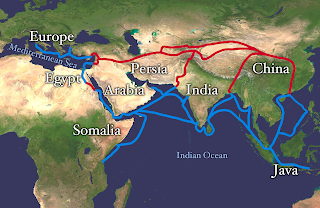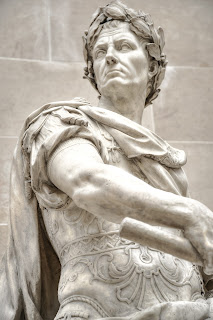The Silk Road carries a captivating tale that reminds us of the incredible impact of human curiosity, ambition, and interconnectedness. This ancient trade network, spanning over 7,000 miles across continents, brought together diverse civilizations, leading to an extraordinary exchange of goods, ideas, and culture. In this blog post, join us on a captivating journey along the Silk Road as we explore its historical significance, the treasures that flowed through its paths, and the profound influence it had on the societies it touched.
 |
| by-https://commons.wikimedia.org/wiki/User:Splette |
Origins and Route:
The Silk Road's origins can be traced back to the Han Dynasty in Ancient China. During this time, Emperor Wu recognized the potential of trade beyond China's borders, which led to the expansion of routes connecting the Middle Kingdom with Central Asia and beyond. Over time, the Silk Road evolved and reached its peak during the Tang Dynasty, a period of vibrant trade and thriving cultural exchange. This extensive network of routes connected China, Central Asia, the Indian subcontinent, the Middle East, and even parts of Europe.
The Silk Road consisted of various routes, each with its own unique characteristics and significance. The Northern Route stretched across the vast steppes of Central Asia, facilitating trade between China and prosperous city-states like Samarkand, Bukhara, and Merv. Caravans carrying silk, precious goods, and knowledge embarked on the challenging journey, encountering nomadic tribes and establishing trading posts along the way.
The Southern Route, also known as the Southern Silk Road, offered an alternative path through the mountainous regions of Central Asia, connecting China with India and the Persian Gulf. This route facilitated the exchange of goods such as spices, precious stones, and textiles, enriching the cultures and economies of the regions it connected.
The Maritime Silk Road also played a significant role, enabling maritime trade between China, Southeast Asia, the Indian subcontinent, and the East African coast. Ships sailed through the vast Indian Ocean, transporting valuable commodities like silk, ceramics, spices, and precious metals. This maritime route opened new avenues for cultural exchange and trade, bringing diverse civilizations into contact with one another.
Along the Silk Road, numerous cities and regions emerged as vibrant trade hubs, cultural melting pots, and centers of intellectual exchange. Chang'an (present-day Xi'an) served as the eastern starting point of the Silk Road, a bustling capital city that showcased the might and sophistication of ancient China. Merchants, scholars, and artisans from different regions flocked to this cosmopolitan hub.
Moving westward, the city of Samarkand in present-day Uzbekistan gained prominence as a center of commerce and culture. Under the rule of the Persian-speaking Sogdians, Samarkand flourished and later became a major hub of the Islamic world. Known as a center of learning, it became synonymous with the Silk Road, featuring grand bazaars and architectural marvels.
by- John Hill source-https://en.wikipedia.org/wiki/User:John_Hill
Kashgar, situated in China's Xinjiang region, played a crucial role as a crossroads where various branches of the Silk Road converged. It served as a hub for trade between China, Central Asia, and the Indian subcontinent. The city's vibrant and cosmopolitan trading center blended Uighur, Persian, and Turkic influences, creating a unique cultural atmosphere.
Constantinople (present-day Istanbul) marked the western terminus of the Silk Road. Strategically located at the crossroads of Europe and Asia, this Byzantine city acted as a gateway to the West. Constantinople thrived as a hub where Eastern and Western cultures intersected, fostering the exchange of goods, ideas, and technologies.
Goods and Trade:
Silk, a highly iconic commodity, dominated trade along the Silk Road. China's closely guarded secret of silk production became the foundation of this ancient trade network. The cultivation of silkworms, silk reeling, and weaving techniques were carefully protected secrets in ancient China. Silk fascinated people from diverse cultures, making it a profitable venture for Chinese merchants and a much-desired luxury in the Western world.
Beyond silk, the Silk Road witnessed the exchange of a wide array of other commodities that transformed the economic and cultural landscapes of the regions it passed through. Spices and aromatics played a significant role in trade. Goods such as cinnamon, cardamom, saffron, and frankincense traveled long distances, tantalizing the senses and enriching culinary practices. These exotic flavors not only expanded the palates of people along the Silk Road but also found their way into medicinal remedies, enhancing traditional healing practices.
by-Neri_Oxman source-https://en.wikipedia.org/wiki/Neri_Oxman
Precious metals and gemstones were highly sought-after commodities along the Silk Road. Gold and silver, mined from various regions, captivated traders and played a vital role in economic transactions. These precious metals served as currency and fueled the growth of empires and prosperous trading cities. Jade, renowned for its beauty and symbolic significance, was highly prized by the Chinese and found its way along the Silk Road. Gemstones such as rubies, emeralds, and sapphires also embarked on these routes, capturing the imagination of those fortunate enough to encounter them.
Cultural Exchange and Ideas:
The Silk Road served as more than just a trade route; it acted as a bridge for the exchange of ideas, beliefs, and cultural practices. It was a catalyst for the spread of religions, the exchange of artistic influences, the sharing of knowledge, and the development of languages.
The Silk Road witnessed the spread of religions across vast distances. Buddhism, originating in India, found its way to Central Asia, China, and beyond, leaving a profound impact on the cultures it encountered. Christianity, emerging from the Mediterranean region, made its way eastward, reaching Central Asia and China, where it merged with local belief systems to create unique forms of worship. Islam expanded westward along the Silk Road, embracing regions along its path and creating a lasting legacy of faith.
Artistic expression and architectural styles flourished as a result of cultural exchange along the Silk Road. Monuments, murals, and sculptures discovered along its routes reflect the fusion of Persian, Indian, Greek, and Chinese artistic elements. The grandeur of Samarkand's Registan Square, the Mogao Caves near Dunhuang, and the stunning Buddhist art found along the Silk Road bear witness to the diverse cultural influences that shaped these artistic creations.
source-https://www.centralasia-travel.com/upload/photos/7822.jpg
Intellectual and scientific exchange thrived along the Silk Road, contributing to advancements in various fields. Scholars, merchants, and travelers carried knowledge across borders, resulting in the dissemination of ideas in astronomy, mathematics, medicine, and other disciplines. The exchange of knowledge and ideas between civilizations along the Silk Road contributed to the progress of human civilization as a whole.
Language and writing systems also developed and evolved along the Silk Road. The need for communication between diverse cultures led to the development of scripts such as Uighur, Sogdian, Kharosthi, and others. These scripts facilitated trade, cultural exchange, and the transmission of knowledge, leaving a linguistic legacy that attests to the vibrant intermingling of cultures along the SilkRoad.
Conclusion:
The Silk Road stands as a testament to the transformative power of trade, cultural exchange, and human interaction. It fostered an unprecedented level of interconnectedness, shaping the destinies of civilizations and leaving an indelible mark on history. As we reflect upon the rich tapestry of history woven along this fabled route, let us celebrate the remarkable human endeavour that was the Silk Road—an enduring symbol of the indomitable spirit of exploration, cultural exchange, and the unifying potential of trade.












